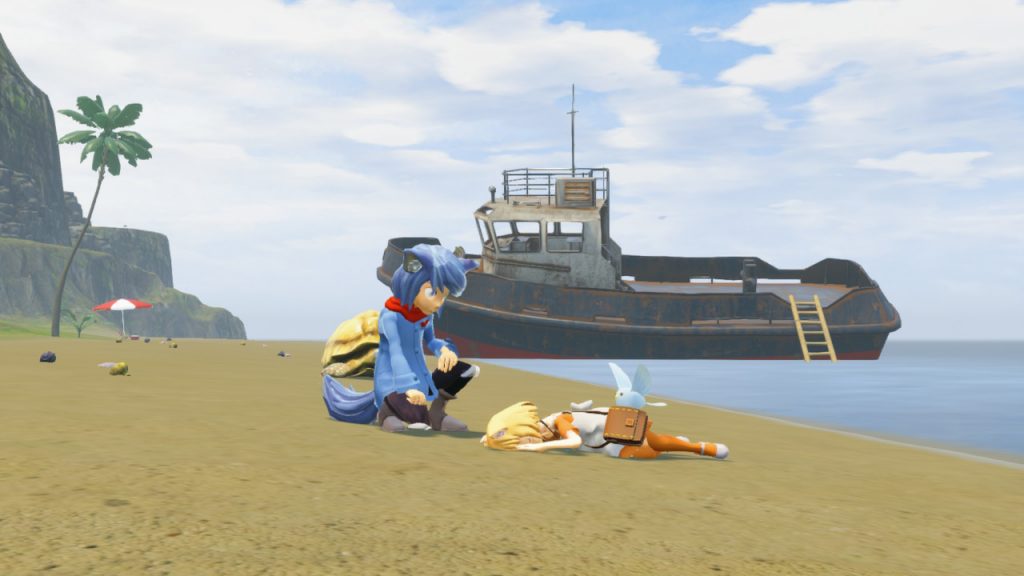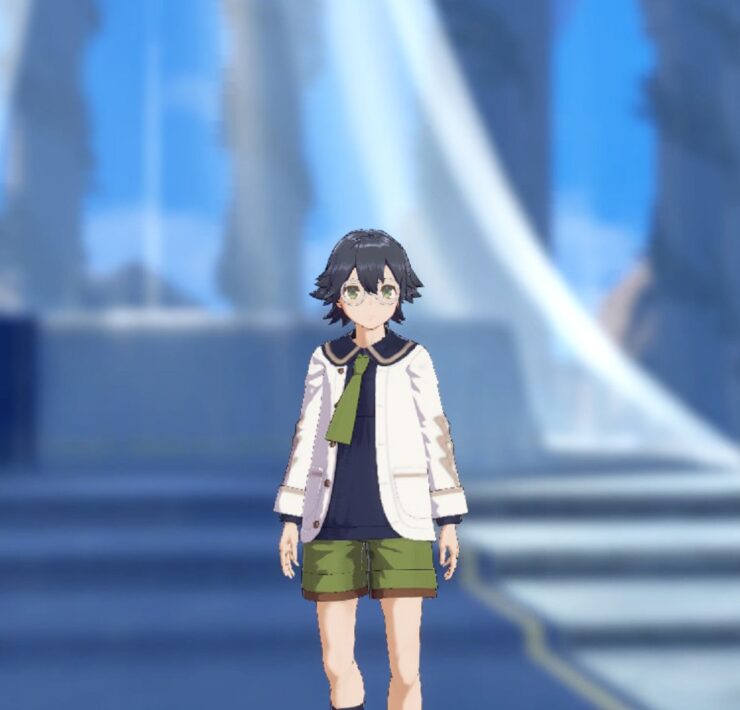Giraffe and Annika Switch Review – Catastrophic

Have you ever watched a trailer for a video game and immediately knew everything about it before ever playing it? Well, that was Giraffe and Annika for me. As soon as I finished watching the Japanese trailer, I had a somber feeling come over me, because I knew deep down the experience I was about to have. But we are not here to talk about how I judged a game by its cover. Let me tell you how I judged the whole game after playing it to completion and whether or not you should dive in yourself.

You play as Annika, one of the titular characters, and you soon meet Giraffe, the other half of the title, who asks you for help in saving the world of sorts by collecting three gems after you banged your head and woke up in a world you do not even recognize. Well, to be perfectly honest, the story is equal parts simple and to the point and also convoluted and stupid. Somewhere deep inside of Giraffe and Annika, we have a sweet story of longing and separation, but somehow that simple narrative is muddied by a nonsensical world, beyond boring NPCs that add very little to the narrative, and tiring journeys through some of the worst dungeons I have ever played in a video game.
The game takes a pacifist approach, so you will at no point learn or use actions to attack. When traversing through dungeons, you will come across ghosts who can attack you, but you have no way to defend yourself. You simply need to avoid them as best as you can. As Annika completes dungeons, she earns mundane abilities that allow her to access more of the island. Basic abilities like jumping, swimming longer, and running are locked behind a progression system similar to a metroidvania game, and this makes the small world of Giraffe and Annika feel even smaller.

I would separate the gameplay into three different sections, because it is hard to judge them all together. Firstly, we have a story-based adventure game. Secondly, we have a frustrating and unfair 3D platformer. And finally, we have a rhythm game that feels randomly placed in the middle of the game for no reason at all.
The story-based adventure is a somewhat enjoyable area of Giraffe and Annika, but that is honestly not saying a whole lot. It is quite the linear adventure, and you are simply trying to figure out the mystery of where you are and the importance of these gems that Giraffe asked you to help collect. Annika does not really go much further than that with her thinking. It is as if she is unphased by the bizarre world around her and the strange task immediately thrown in her direction. She feels a bit too one-dimensional for a story that does lean on some heavy topics at times, and it is difficult to take her or the situation at hand seriously.
The platforming, however, is just plain horrible. The way Annika moves feels like a bad PS1-era 3D platformer, and some areas of the game contain difficulty curves so extreme that it feels like a completely different game at times. Most of the dungeons require Annika to jump and dodge in such a way that you would expect the controls to be both precise and fluid, and neither of those elements exist. Movement in clunky, and platforming is a real pain because of old-feeling movement limitations. Later dungeons require way too much precision jumping for a game that does not allow its players precise controls, and this is truly unforgivable.

Finally, we come to the rhythm section of the game, which is delivered by the dungeon boss. Each “boss”, if that’s what you want to call them, performs a magical dance that throws balls of light that you need to hit within a timely manner or else you take damage. You also need to dodge left and right to periodically avoid magical attacks that are coming your way, but this is honestly not too hard. There are three settings prior to each battle that allows you to play the rhythm game in Easy, Medium, or Hard. I found very little difference between Easy and Medium throughout the game, but Hard does offer a decent challenge for those looking for some fun rhythmic gameplay.
One of my key takeaways is that the rhythm side of the game felt so fluid that it makes me think the developers created a rhythm game and then built an adventure around it. At no point in the game did the story imply Annika or anyone else of importance enjoyed music or dancing until it was relevant, but they were random themes throughout the game. And I guess they had to be, because the boss fights were heavily focused on music, rhythm, and dancing. The only problem with this approach is that the rhythm parts of the game were so few and far between, and they did not last more than a couple minutes each. This means that Giraffe and Annika leans a lot more on its adventuring and platforming, the two lesser parts of the game, and neglects to utilize rhythm, its best asset, more. Whatever the reason is for this decision, you cannot deny the huge disconnect that the rhythm parts have with the rest of the game.
You would think that if the rhythm battles were one of the best parts of the game, the music would follow, but unfortunately the soundtrack is bland and forgettable. Every section of the game, including the cute storyboard used for storytelling, lacks memorable music to give each of the important areas more life.

Throughout the game, there are collectables in the form of “Meowsterpieces”, and they are essentially amateur drawings of cats. These drawings range from pretty good to really bad, and it is such a weird thing to collect. But you would think that collecting these is purely optional. Oh, contraire. You will need to collect at least 16 Meowsterpieces to access the end game, which is a poor design decision and something that should absolutely be communicated to players early in the game. Essentially, you collect these paintings through various means, and you will bring them to a ghost that operates a museum of sorts. Like Blathers in Animal Crossing: New Horizons, this ghost depends solely on you to collect these paintings and deliver them to him. Upon turning them in, you will receive stamps, and earning a certain amount of stamps rewards you with in-game items like outfits and a very important ticket.
Other items are weirdly hidden throughout the game behind colored doors that you will need the appropriately colored key to open (Side Note: Who designed this place? One blue key opens all of the blue doors on the island? Colored skeleton keys? What kind of security is this?). I wish that such items were not necessary, but the game expects you to remember all of the obscure areas of the island where colored doors exist, even inside of caves and houses that you never even need to enter. It is a strange design choice, especially after you gain the ability to jump and can clearly jump over fences where locked colored doors restrict. Since there are invisible walls in place, you are not able to make the full leap, but it does look strange and does not make sense physically.
Another poor design choice is the in-game clock. Although it makes sense to a degree, it mostly restricts progression and simply adds more steps to a task. A carpenter ghost can only build the bridge at night? Well, I guess I have to run home real quick and sleep until evening. A dressmaker requires three days to make your new dress? Okay. I guess I will just sleep in her bed for three straight days. There is no punishment for doing this, so why does it even exist? The game even has beds all over the place to encourage sleeping until a certain time, but why not eliminate the mechanic completely if you make it so easy to deem it meaningless?

From a technical standpoint, Giraffe and Annika suffers from a tremendous amount of glitches, design issues, and graphical problems. For starters, riding on moving objects like floating platforms and boats can result in some insane rubberbanding where Annika will shoot across the screen to her death. Also while riding, Annika will bounce off of certain objects in such a way that it can easily throw her off, plummeting to her death. NPCs, while moving, will glide on the floor and do not follow their footstep pattern at all, and they even move at a weirdly fast walking speed that makes it look even more awkward. Sadly, I could spend 20 minutes on technical issues, but I think you get the point.
The graphics, for the most part, look really good, but there are certain character models that are ugly and lack character. It honestly looks like they spent a lot more time on certain areas of the game than others, and it really shows. I wish the team spent as much time on the other NPCs as they did on Annika’s model, because she really does stand out and looks super-cute. Sadly, and you can probably tell, as this is the theme, the bad simply outweighs the good tremendously when it comes to all areas of the game, and that even includes the look and feel.
Considering this costs $29.99 digitally / $49.99 physically and only lasts you about 5 hours, I cannot find it in my right mind to ever recommend this game. It was a pain to get through, and there are no true redeeming qualities about Giraffe and Annika that justify such a price tag. You know it is a bad sign when your 9 and 5-year-old children are begging you to turn the game off, and these are two kids that will literally watch anything on a screen. If you have been waiting impatiently for this and did not mind the high entry fee, I am sorry that this is not the review you are looking for. This is something you should stay far, far away from, and in my case, a perfect example of why it’s okay to judge a game by its cover some times.

Giraffe and Annika Switch Review provided by Nintendo Link
Review also available on OpenCritic
Developer: Atelier Mimina
Publisher: Bulbware
Release Date: August 25, 2020
Price: $29.99, £26.99, €29.99
Game Size: 2.2 GB

What's Your Reaction?
My name is Jason Capp. I am a husband, father, son, and brother, and I am a gamer, a writer, and a wannabe pro wrestler. It is hard to erase the smile on this simple man.








Main character is cute
Rhythm sections are pretty fun
Story is convoluted and not well told
Glitches and errors for days
Horrific platforming/jumping mechanics
Criminally short and crazy high price tag